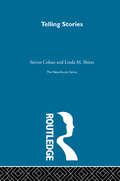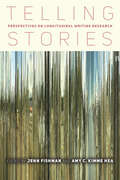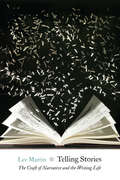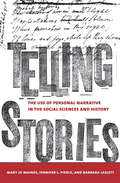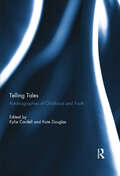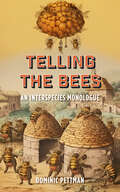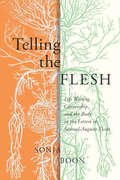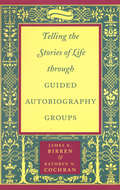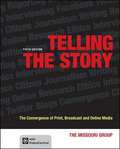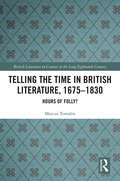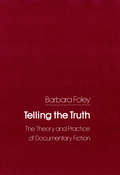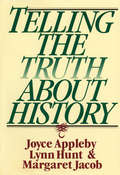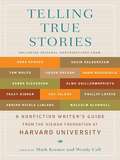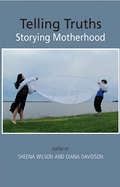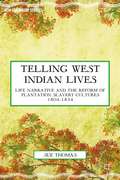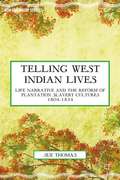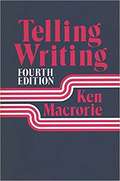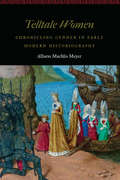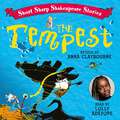- Table View
- List View
Telling Stories: A Theoretical Analysis Of Narrative Fiction (New Accents Ser.)
by Steven Cohan Linda M. ShiresFirst Published in 2002. Routledge is an imprint of Taylor & Francis, an informa company.
Telling Stories: Perspectives on Longitudinal Writing Research
by Jenn Fishman Amy Kimme HeaIn Telling Stories, more than a dozen longitudinal writing researchers look beyond conventional project findings to story their work and, in doing so, offer otherwise unavailable glimpses into the logics and logistics of long-range studies of writing. The result is a volume that centers interrelations among people, places, and politics across two decades of praxis and an array of educational sites: two-year colleges, a senior military college, an adult literacy center, a small liberal arts college, and both public and private four-year universities. Contributors share direct knowledge of longitudinal writing research, citing project data (e.g., interview transcripts, research notes, and journals), descriptions drawn from memory, and extended personal reflections. The resulting stories, tempered by the research and scholarship of others, convey a sense of longitudinal research as a lived activity as well as a prominent and consequential approach to inquiry. Yet Telling Stories is not a how-to guide, nor is it written for longitudinal researchers alone. Instead, this volume addresses issues about writing research that are germane to all who conduct or count on it. Such topics include building and sustaining good interpersonal research relations, ethically negotiating the institutional power dynamics that undergird writing research, effectively using knowledge from longitudinal studies to advocate for writers and writing educators, and improving both conceptual and concrete resources for long-range research in writing studies.
Telling Stories: The Craft of Narrative and the Writing Life
by Lee MartinA prolific and award-winning writer, Lee Martin has put pen to paper to offer his wisdom, honed during thirty years of teaching the oh-so-elusive art of writing. Telling Stories is intended for anyone interested in thinking more about the elements of storytelling in short stories, novels, and memoirs. Martin clearly delineates helpful and practical techniques for demystifying the writing process and provides tools for perfecting the art of the scene, characterization, detail, point of view, language, and revision—in short, the art of writing. His discussion of the craft in his own life draws from experiences, memories, and stories to provide a more personal perspective on the elements of writing. Martin provides encouragement by sharing what he’s learned from his journey through frustrations, challenges, and successes. Most important, Telling Stories emphasizes that you are not alone on this journey and that writers must remain focused on what they love: the process of moving words on the page. By focusing on that purpose, Martin contends, the journey will always take you where you’re meant to go.
Telling Stories: The Use of Personal Narratives in the Social Sciences and History
by Mary Jo MaynesMary Jo Maynes, Jennifer L. Pierce, and Barbara Laslett argue that personal narratives--autobiographies, oral histories, life history interviews, and memoirs--are an important research tool for understanding the relationship between people and their societies. Gathering examples from throughout the world and from premodern as well as contemporary cultures, they draw from labor history and class analysis, feminist sociology, race relations, and anthropology to demonstrate the value of personal narratives for scholars and students alike. Telling Stories explores why and how personal narratives should be used as evidence, and the methods and pitfalls of their use. The authors stress the importance of recognizing that stories that people tell about their lives are never simply individual. Rather, they are told in historically specific times and settings and call on rules, models, and social experiences that govern how story elements link together in the process of self-narration. Stories show how individuals' motivations, emotions, and imaginations have been shaped by their cumulative life experiences. In turn, Telling Stories demonstrates how the knowledge produced by personal narrative analysis is not simply contained in the stories told; the understanding that takes place between narrator and analyst and between analyst and audience enriches the results immeasurably.
Telling Tales: Autobiographies Of Childhood And Youth
by Kylie Cardell Kate DouglasYoung writers have historically played a pivotal role in shaping autobiographical genres and this continues into the graphic and digital texts which characterise contemporary life writing. This volume offers a selection of pertinent case studies which illuminate some of the core themes which have come to characterise autobiographical writings of childhood, including: cultural and identity representations and tensions, coming into knowledge and education, sexuality, prejudice, war, and trauma. The book also reveals preoccupations with the cultural forms of autobiographical writings of childhood and youth take, engaging in discussions of archives, graphic texts, digital forms, testimony, didacticism in autobiography and the anthologising of life writing. This collection will open up broader conversations about the scope of life writing about childhood and youth and the importance of life writing genres in prompting dialogues about literary cultures and coming of age. This book was originally published as a special issue of Prose Studies.
Telling the Bees: An Interspecies Monologue
by Dominic PettmanIn a bid to wean himself off Facebook and Twitter, media scholar and cultural theorist Dominic Pettman decided to revive an ancient custom. He decided to tell the local bees of his thoughts, theories, musings, and meditations. The result was an apian journal that parses the daily news and the routines of modern life in a more sustained and reflective way than the Pavlovian posts to which we are so addicted.The account that emerges from Pettman’s regular discussion with the bees forms a compelling portrait of the tumultuous period running from the Fall of 2019 to New Year’s Eve, 2022. What began as a reflection on the traumatic effects of an “unprecedented” presidency soon evolved into a real-time response to the equally extraordinary events of the pandemic and its aftermath. One key concern that emerges from Pettman’s ongoing discussion with the bees is the extent to which, thanks to the alienating effects of neoliberalism, we were already engaged in an advanced form of social distancing long before anyone had heard of COVID. Other key themes include education, human-animal relations, climate change, mediated intimacy, attention ecologies, collective memory, slow violence, the self-fulfilling prophecy that is New York City, the never-ending end of history, and the mundane strategies we share in a bid to forge on, despite the accumulating challenges of the twenty-first century. Telling the Bees is an invitation to rediscover the art of reflection and a profound meditation on human connection, alienation, and our collective yearning for intimacy in an age of distance. Through what Pettman describes as an "interspecies monologue," readers are treated to a unique perspective on navigating the complexities of the twenty-first century, inspired by the ingenuity and resilience of our natural cohabitants.
Telling the Flesh: Life Writing, Citizenship, and the Body in the Letters to Samuel Auguste Tissot
by Sonja BoonIn the second half of the eighteenth century, celebrated Swiss physician Samuel Auguste Tissot (1728-1797) received over 1,200 medical consultation letters from across Europe and beyond. <P><P>Written by individuals seeking respite from a range of ailments, these letters offer valuable insight into the nature of physical suffering. Plaintive, desperate, querulous, fearful, frustrated, and sometimes arrogant and self-interested in tone, the letters to Tissot not only express the struggle of individuals to understand the body and its workings, but also reveal the close connections between embodiment and politics. Through the process of writing letters to describe their ailments, the correspondents created textual versions of themselves, articulating identities shaped by their physical experiences. Using these identities and experiences as examples, Sonja Boon argues that the complaints voiced in the letters were intimately linked to broader social and political discourses of citizenship in the late eighteenth century, a period beset with concerns about depopulation, moral depravity, and corporeal excess, and organized around intricate rules of propriety. Contributing to the fields of literary criticism, history, gender and sexuality studies, and history of medicine, Telling the Flesh establishes a compelling argument about the connections between health, politics, and identity.
Telling the Flesh: Life Writing, Citizenship, and the Body in the Letters to Samuel Auguste Tissot (McGill-Queen's/Associated Medical Services Studies in the History of Medicine, Health, and Society #44)
by Sonja BoonIn the second half of the eighteenth century, celebrated Swiss physician Samuel Auguste Tissot (1728-1797) received over 1,200 medical consultation letters from across Europe and beyond. Written by individuals seeking respite from a range of ailments, these letters offer valuable insight into the nature of physical suffering. Plaintive, desperate, querulous, fearful, frustrated, and sometimes arrogant and self-interested in tone, the letters to Tissot not only express the struggle of individuals to understand the body and its workings, but also reveal the close connections between embodiment and politics. Through the process of writing letters to describe their ailments, the correspondents created textual versions of themselves, articulating identities shaped by their physical experiences. Using these identities and experiences as examples, Sonja Boon argues that the complaints voiced in the letters were intimately linked to broader social and political discourses of citizenship in the late eighteenth century, a period beset with concerns about depopulation, moral depravity, and corporeal excess, and organized around intricate rules of propriety. Contributing to the fields of literary criticism, history, gender and sexuality studies, and history of medicine, Telling the Flesh establishes a compelling argument about the connections between health, politics, and identity.
Telling the Stories of Life through Guided Autobiography Groups
by James E. Birren Kathryn N. CochranTelling the Stories of Life through Guided Autobiography Groups, based on James Birren's 25 years of conducting autobiography groups, discusses all the topics an organizer faces while developing a program for adults who want to recall and write down their life histories. This book is ideal for adult education programs, church groups, social workers, psychologists, gerontologists, and others who work with adults who might be interested in exploring, recording, or sharing their personal histories. It helps professionals and trained workshop leaders at community centers, senior centers, schools and other settings guide group participants in exploring major themes of their lives so that they can organize and write their stories and share them in a group with others on the same journey. This exercise is rewarding for adults of any age in a period of transition or with interest in gaining insight from their own stories. Personal development and a feeling of connection to other participants and their stories is a natural outcome of this process. This book provides background material and detailed lesson plans for those who wish to develop and lead an autobiography group.The authors explain the concept of guided autobiography, discuss the benefits to the group participants, and provide logistical information on how to plan, organize, and set up a group. An appendix provides exercises, handouts, and suggested adaptations for specific groups. The book also explains a systematic method of priming memories, including the history of family and of one's life work, the role of money, health and the body, and ideas about death.At a time when rapid change has created a widespread yearning to write down and exchange personal accounts, sharing life stories can reveal a great deal about how we have come to be the persons we are. Telling the Stories of Life through Guided Autobiography Groups shows how to organize, record, and share life experiences through a proven and effective technique.
Telling the Story: The Convergence of Print, Broadcast and Online Media (5th Edition)
by Brian S. Brooks Daryl R. Moen George Kennedy Don RanlyThe way journalists work and how the public gets its news have changed dramatically. The media landscape has evolved and converged, and to succeed, journalism students must learn the fundamentals of journalism -- how to research, write, and tell a great story -- and use these skills in an increasingly digital world. The Missouri Group continues to offer the best coverage of the basics while keeping pace with the trends in the field. In Telling the Story, 5th edition, The Missouri Group goes even further with concise, how-to coverage of the new journalistic skills that take advantage of new technologies -- from blogging to researching online, to using social media and conducting online interviews.
Telling the Time in British Literature, 1675-1830: Hours of Folly? (British Literature in Context in the Long Eighteenth Century)
by Marcus TomalinAlthough the broad topic of time and literature in the long eighteenth century has received focused attention from successive generations of literary critics, this book adopts a radically new approach to the subject. Taking inspiration from recent revisionist accounts of the horological practices of the age, as well as current trends in ecocriticism, historical prosody, sensory history, social history, and new materialism, it offers a pioneering investigation of themes that have never previously received sustained critical scrutiny. Specifically, it explores how the essayists, poets, playwrights, and novelists of the period meditated deeply upon the physical form, social functions, and philosophical implications of particular time-telling objects. Consequently, each chapter considers a different device – mechanical watches, pendulums, sandglasses, sundials, flowers, and bells – and the literary responses of significant figures such as Alexander Pope, Anne Steele, William Wordsworth, Samuel Taylor Coleridge, Charlotte Smith, and William Hazlitt are carefully examined.
Telling the Truth: The Theory and Practice of Documentary Fiction
by Barbara C. FoleyBarbara Foley here focuses on the relatively neglected genre of documentary fiction: novels that are continually near the borderline between factual and fictive discourse. She links the development of the genre over three centuries to the evolution of capitalism, but her analyses of literary texts depart significantly from those of most current Marxist critics. Foley maintains that Marxist theory has yet to produce a satisfactory theory of mimesis or of the development of genres, and she addresses such key issues as the problem of reference and the nature of generic distinctions. Among the authors whom Foley treats are Defoe, Scott, George Eliot, Joyce, Isherwood, Dos Passos, William Wells Brown, Ishmael Reed, and Ernest Gaines.
Telling the Truth about History
by Margaret Jacob Lynn Hunt Joyce Appleby"A fascinating historiographical essay. . . . An unusually lucid and inclusive explication of what it ultimately at stake in the culture wars over the nature, goals, and efficacy of history as a discipline."--Booklist
Telling True Stories: A Nonfiction Writers' Guide from the Nieman Foundation at Harvard University
by Wendy Call Mark KramerInspiring stories and practical advice from America's most respected journalists The country's most prominent journalists and nonfiction authors gather each year at Harvard's Nieman Conference on Narrative Journalism. <P><P>Telling True Stories presents their best advice--covering everything from finding a good topic, to structuring narrative stories, to writing and selling your first book. More than fifty well-known writers offer their most powerful tips, including: * Tom Wolfe on the emotional core of the story * Gay Talese on writing about private lives * Malcolm Gladwell on the limits of profiles * Nora Ephron on narrative writing and screenwriters * Alma Guillermoprieto on telling the story and telling the truth * Dozens of Pulitzer Prize-winning journalists from the Atlantic Monthly, New Yorker, New York Times, Los Angeles Times, Washington Post and more . . . The essays contain important counsel for new and career journalists, as well as for freelance writers, radio producers, and memoirists. Packed with refreshingly candid and insightful recommendations, Telling True Stories will show anyone fascinated by the art of writing nonfiction how to bring people, scenes, and ideas to life on the page.
Telling Truths: Storying Motherhood
by Sheena WilsonTelling Truths: Storying Motherhood is a collection of creative non-fiction essays. Through story, contributing authors explore how expectations collide with the complex realities we face as we mother. They illustrate how mothering is inextricably linked to the positions we occupy within our specific socio-cultural contexts; how our versions of mothering are transformed in relationship to the children we raise, long for, and mourn. Together, as writers and readers, as mothers and parents and communities, we are rewriting and rereading and reinventing what it means to mother and parent our children at this moment in history. This anthology is an important contribution to ongoing dialogues that resist traditional expectations around motherhood.
Telling West Indian Lives: Life Narrative and the Reform of Plantation Slavery Cultures 1804–1834 (New Caribbean Studies)
by S. ThomasTelling West Indian Lives: Life Narrative and the Reform of Plantation Slavery Cultures 1804-1834 draws historical and literary attention to life story and narration in the late plantation slavery period. Drawing on new archival research, it highlights the ways written narrative shaped evangelical, philanthropic, and antislavery reform projects.
Telling West Indian Lives: Life Narrative and the Reform of Plantation Slavery Cultures, 1804-1834 (New Caribbean Studies)
by Sue ThomasTelling West Indian Lives: Life Narrative and the Reform of Plantation Slavery Cultures 1804-1834 draws historical and literary attention to life story and narration in the late plantation slavery period. Drawing on new archival research, it highlights the ways written narrative shaped evangelical, philanthropic, and antislavery reform projects.
Telling Writing
by Ken MacrorieWhy is Telling Writing, now in its fourth edition, still going strong in hundreds of colleges and universities? Ken Macrorie touches on the answer in his preface: "Good teaching in any field isn't a matter of employing gimmicks and choosing from a damnfool encyclopedia of tricks to play on students . . . but a matter of setting up a climate friendly to learning and then challenging learners to connect their experience and ideas with those of the accepted authorities or producers. Students can't become truly educated unless they grow out of and beyond themselves . . . Telling Writing gives them an indispensable base, a knowledge of themselves on which to grow." <p><p> Macrorie's approach works because it helps students break away from the deadly academic prose fostered by so many writing courses and enables them to write about and from their own experiences.
Telltale Women: Chronicling Gender in Early Modern Historiography (Women and Gender in the Early Modern World)
by Allison Machlis MeyerTelltale Women fundamentally reimagines the relationship between the history play and its source material as an intertextual one, presenting evidence for a new narrative about how—and why—these genres disparately chronicle the histories of royal women. Allison Machlis Meyer challenges established perceptions of source study, historiography, and the staging of gender politics in well-known drama by arguing that chronicles and political histories frequently value women&’s political interventions and use narrative techniques to invest their voices with authority. Dramatists who used these sources for their history plays thus encountered a historical record that offered surprisingly ample precedents for depicting women&’s perspectives and political influence as legitimate, and writers for the commercial theater grappled with such precedents by reshaping source material to create stage representations of royal women that condemned queenship and female power. By tracing how the sanctioning of women&’s political participation changes from the narrative page to the dramatic stage, Meyer demonstrates that gender politics in both canonical and noncanonical history plays emerge from playwrights&’ intertextual engagements with a rich alternative view of women in the narrative historiography of the sixteenth and seventeenth centuries.
Telugu Bata class 8 - Andhra Pradesh board: తెలుగుబాట ఎనిమిదవ తరగతి ఆంధ్ర ప్రదేశ్ బోర్డ్
by State Council of Educational Research and Training Andhra Pradeshఈ పాఠ్యపుస్తకం విద్యార్థుల భాషా అభివృద్ధిని మెరుగుపరచడానికి రూపొందించబడింది. ఇది భారత రాజ్యాంగ పీఠికతో మొదలై, తెలుగు భాషా సంస్కృతి, సాహిత్య ప్రాముఖ్యత, మరియు దేశభక్తి ఇతివృత్తాలతో రూపొందించబడింది. పాఠ్యాంశాలలో కథలు, గేయాలు, శతకాలు, వ్యాసాలు, నాటకాలు, మరియు కవిత్వ రూపాలు ఉన్నాయి. నూతన విద్యావిధానం (NEP 2020) దృష్టిలో ఉంచుకుని, సమాజ సేవ, నైతిక విలువలు, మరియు జాతీయ సమైక్యతను ఉల్లేఖిస్తూ రూపొందించబడింది. ఈ పాఠ్యపుస్తకం ముఖ్యంగా భావవ్యక్తీకరణ, విమర్శనాత్మక ఆలోచన, సృజనాత్మకత, మరియు భాషా నైపుణ్యాలను ప్రోత్సహిస్తుంది. ఉపాధ్యాయులకు మరియు విద్యార్థులకు ఉపయోగకరమైన సూచనలు అందించబడాయి. పాఠ్యాంశాలు విద్యార్థుల అనుభవాలను అన్వయించుకునేలా ప్రణాళిక చేయబడినాయి.
Telugu class 6 - Andhra Pradesh Board: తెలుగు బాట తెలుగు వాచకం ఆరవ తరగతి ఆంధ్ర ప్రదేశ్ బోర్డ్.
by State Council of Educational Research and Training Andhra Pradesh"తెలుగు బాట 6" ఆరవ తరగతి విద్యార్థులకు రూపొందించిన పాఠ్యపుస్తకంగా, భాషాభివృద్ధి, మానవతా విలువలు, దేశభక్తి, సృజనాత్మకతలపై దృష్టి సారిస్తుంది. ఈ పుస్తకం జాతీయ విద్యా విధానం-2019కు అనుగుణంగా రూపొందించబడింది, పిల్లల ఆలోచనా శక్తిని, వ్యక్తీకరణ సామర్థ్యాన్ని పెంపొందించడమే లక్ష్యం. ఇందులో పాఠాలు కథలు, గేయాలు, వ్యాసాలు, పద్యాలు, జాతీయ గీతాలు వంటి వివిధ సాహిత్య ప్రక్రియల ద్వారా విద్యార్థులలో భాషా జ్ఞానంతో పాటు నైతిక విలువలు పెంపొందించేలా రూపొందించబడ్డాయి. ఉపాధ్యాయులకు పాఠ్య బోధనకు సూచనలు అందించబడటంతో పాటు, పిల్లలకు సులభమయిన భాషా అభ్యాసాలు, చర్చలు, ప్రాజెక్టు పనులు ఇవ్వబడ్డాయి. "తక్కువ పాఠాలు - లోతైన అవగాహన" అన్న ధ్యేయంతో రూపొందించబడిన ఈ పుస్తకం, పిల్లలకు చదువుతో ఆనందాన్ని కలిగించడంలో సహాయపడుతుంది.
Telugu class 7 - Andhra Pradesh Board: తెలుగుబాట ఏడవ తరగతి ఆంధ్ర ప్రదేశ్ బోర్డ్
by State Council of Educational Research and Training Andhra Pradeshతెలుగుబాట - ఏడవ తరగతి పాఠ్యపుస్తకం ఈ పుస్తకం జాతీయ విద్యా ప్రణాళికకు అనుగుణంగా రూపొందించబడింది. ఇది విద్యార్థులలో భాషా నైపుణ్యాలు, సృజనాత్మకత, సామాజిక అవగాహనలను పెంపొందించేందుకు ఉపయుక్తంగా ఉంటుంది. ఈ పాఠ్యపుస్తకంలో భాషకు సంబంధించిన పాఠాలు, పద్యాలు, వ్యాసాలు, పదవిజ్ఞానాలు ఉంటాయి. కథలు, నాటకాలు, నాటకీకరణ, ప్రాజెక్టు పనుల ద్వారా విద్యార్థులలో వ్యక్తిత్వ వికాసం, జాతీయభావం పెంపొందించడమే లక్ష్యం. పుస్తకంలో అక్షరం, మాయాకంబళి వంటి పాఠాలు విద్యార్థులలో ఆత్మవిశ్వాసాన్ని, సృజనాత్మకతను పెంపొందించేవిగా ఉన్నాయి. అందించబడిన కాంపోజిట్ కోర్సు ద్వారా భాషా అభ్యాసాన్ని మెరుగుపరచడం, నైతిక విలువలు పెంపొందించడం ఈ పుస్తకం ముఖ్య ఉద్దేశ్యాలు.
Telugu Parimalam class 9 - Andhra Pradesh Board: తెలుగుపరిమళం తొమిదవ తరగతి ఆంధ్ర ప్రదేశ్ బోర్డ్
by State Council of Educational Research and Training Andhra Pradeshఈ పాఠ్యపుస్తకం “తెలుగు పరిమళం” విద్యార్థుల భాషా అభివృద్ధి, సృజనాత్మకత, మరియు మానవీయ విలువల వికాసానికి దోహదపడేలా రూపొందించబడింది. ఇందులో పద్యాలు, వచనాలు, కవితలు, వ్యాసాలు వంటి వివిధ సాహిత్యరూపాల్లో ప్రాథమిక విషయాలు విద్యార్థులకు సమర్పించబడ్డాయి. ప్రతి పాఠం మూడు ప్రధాన భాగాలుగా అవగాహన ప్రతిస్పందన, వ్యక్తీకరణ సృజనాత్మకత, భాషాంశాలు విభజించబడింది. పాఠ్యాంశాలు దేశభక్తి, కుటుంబ విలువలు, ప్రకృతి పరిరక్షణ, సామాజిక బాధ్యత, వ్యక్తిత్వ వికాసం, స్నేహం వంటి ఇతివృత్తాల ఆధారంగా రూపొందించబడ్డాయి. ప్రతి పాఠం విద్యార్థుల్లో మంచి నైపుణ్యాలను, మానవీయ గుణాలను అలవర్చేలా ఉంది. ఈ పుస్తకాన్ని రూపొందించడంలో పాల్గొన్న విద్యావేత్తలు, రచయితలు, చిత్రకారులు మొదలైనవారికి ప్రత్యేకంగా కృతజ్ఞతలు తెలిపే ప్రయత్నం కూడా ముందుమాటలో ఉంది. మొత్తానికి, ఈ పాఠ్యపుస్తకం విద్యార్థులకు తెలుగులో అభిరుచి పెంపొందించడమే కాకుండా సమాజంతో అనుసంధానించబడిన విలువలతో కూడిన విద్యను అందించాలనే లక్ష్యంతో రూపొందించబడింది.
Telugu Upavachakam class 9 - Andhra Pradesh Board: తెలుగుపరిమళం ఉపవాచకం తొమిదవ తరగతి ఆంధ్ర ప్రదేశ్ బోర్డ్
by State Council of Educational Research and Training Andhra Pradeshఈ ఉపవాచకం తెలుగు భాషా సాహిత్యాన్ని, సంస్కృతి, సంప్రదాయాల పట్ల విద్యార్థుల్లో ఆసక్తిని కలిగించే విధంగా రూపొందించబడింది. ఇది తొమ్మిదో తరగతి తెలుగు పాఠ్యపుస్తకానికి అనుబంధంగా రూపొందించబడిన మూడవ పఠనాంశ భాగం. దీనిలో ముఖ్యంగా తెలుగు స్వాతంత్ర్య సమరయోధుల జీవితం, సాహిత్యకథలు, మానవీయ విలువలు, ప్రకృతి పట్ల అవగాహన పెంపొందించే కథలు ఉంటాయి. ఈ పుస్తకంలోని కథలు విద్యార్థుల వ్యక్తిత్వ వికాసాన్ని, భాషాపట్ల అభిమానం పెంపొందించేందుకు ఉపయోగపడతాయి. ఉపాధ్యాయులకు ఈ ఉపవాచకాన్ని బోధించేందుకు నిర్దిష్ట సూచనలు ఇవ్వబడ్డాయి ఉదాహరణకు, ప్రతి పాఠానికి ప్రత్యేక పీరియడ్ కేటాయించడం, చర్చలు, సృజనాత్మక పఠనానంతర కృత్యాలు చేయించడం మొదలైనవి. విద్యార్థులకు కూడా వివిధ కథలను చదివి చర్చించడంతో పాటు, స్వయంగా కథలు, కవితలు రాయాలన్న ప్రోత్సాహాన్ని ఈ పుస్తకం కలుగజేస్తుంది. ఈ పాఠ్యపుస్తకంలోని కథలు దేశభక్తి, మానవీయత, కుటుంబ అనుబంధాలు, భాషా శైలిని ఆకర్షణీయంగా పరిచయం చేస్తాయి.
The Tempest (Short, Sharp Shakespeare Stories #28)
by Anna ClaybourneBe not afeard; the isle is full of noises...A powerful storm, a dramatic shipwreck, an enchanted island, a sorcerer's daughter and a handsome prince... Listen on, through magic and mystery, to discover the spell-binding story at the heart of The Tempest, one of Shakespeare's best-loved plays.As well as the story, this audiobook contains information about the background to The Tempest, its major themes, language, and Shakespeare's life during the time he was writing the play. Magic, and its meaning in 16th century England, are also examined, to give some context in which the play was written.The Short, Sharp Shakespeare series consists of six books that retell Shakespeare's most famous plays in modern English. Fun sound effects and atmospheric music accompany each narration, making them a great introduction to "the Bard" for children.(P) 2023 Hodder & Stoughton Limited
